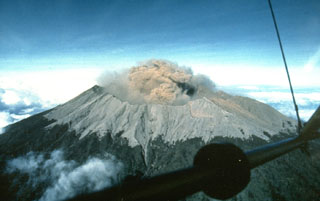Report on Raung (Indonesia) — 15 July-21 July 2020
Smithsonian Institution / US Geological Survey
Weekly Volcanic Activity Report, 15 July-21 July 2020
Managing Editor: Sally Sennert.
Please cite this report as:
Global Volcanism Program, 2020. Report on Raung (Indonesia) (Sennert, S, ed.). Weekly Volcanic Activity Report, 15 July-21 July 2020. Smithsonian Institution and US Geological Survey.
Raung
Indonesia
8.119°S, 114.056°E; summit elev. 3260 m
All times are local (unless otherwise noted)
PVMBG reported that during 1 January-15 July white plumes at Raung rose as high as 50 m above the summit. Seismicity increased on 13 July and then again on 16 July. At 1052 on 16 July observers noted that the color of the emissions had become brownish white and rose higher. A VONA stated that at 1353 an ash plume rose 100 m above the summit and drifted N. At 1356 the color of the emissions changed to white and gray, and plumes rose to 100 m above the summit. During the rest of the day gray and reddish-colored plumes rose 50-200 m. There were 60 emissions recorded in total. During 0000-0600 on 17 July there were a total of 26 emissions characterized by brownish ash plumes rising 50-200 m. PVMBG raised the Alert Level to 2 (on a scale of 1-4), and the public was reminded not to approach the crater within a 2-km radius.
Geological Summary. Raung, one of Java's most active volcanoes, is a massive stratovolcano in easternmost Java that was constructed SW of the rim of Ijen caldera. The unvegetated summit is truncated by a dramatic steep-walled, 2-km-wide caldera that has been the site of frequent historical eruptions. A prehistoric collapse of Gunung Gadung on the W flank produced a large debris avalanche that traveled 79 km, reaching nearly to the Indian Ocean. Raung contains several centers constructed along a NE-SW line, with Gunung Suket and Gunung Gadung stratovolcanoes being located to the NE and W, respectively.
Source: Pusat Vulkanologi dan Mitigasi Bencana Geologi (PVMBG, also known as CVGHM)

